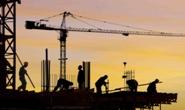Economy

HARDI/ITR Quarterly Construction Forecast Part 1
Written by Sandy Williams
April 30, 2017
Steel Market Update is a member of an association connected to the construction industry called HARDI. HARDI stands for Heating, Air-conditioning & Refrigeration Distributors International. HARDI and The Institute for Trend Research (ITR), an economic forecasting company, work together to gather economic data to provide a forecast to the HARDI members located in the United States and Canada. The information shared in our newsletter is only part of a much larger package seen by participating HARDI member companies.
ITR looks at data using a 3 month and 12 month moving average to determine where business is within the growth cycle. Today’s issue will cover the general economic overview as well as construction forecasts for the Northeast, Mid-Atlantic, and Southeastern Region based on data as of the end of March 2017.
Economic Overview
Industrial production and the GDP are showing the US economy on the rise, says ITR Economics. Metals pricing is up, oil and gas industry is improving and commodity prices are on upward momentum. U.S. GDP rose 2 percent in 2016 with acceleration particularly strong in the second half of the year. ITR expects the U.S. industrial production and the real GDP to accelerate through 2017 and continue to expand in 2018 but at a slower pace. Residential construction is forecast to rise in 2017 with nonresidential picking up this year and next. A downturn is expected in 2019 as the U.S enters a mild recession.
Northeast
Housing permits in the 12 months through February were down 34.5 percent from year ago levels. ITR says permits will rise into 2018 before declining through most of 2019. New York permits were down 51.8 percent due to the impact of a Tax Abatement. Maine and Rhode Island permits increased 14.6 percent during the period while New Hampshire was the bright spot, up 21.1 percent. Single family housing is outperforming multifamily in the Northeast. As permits declined, home prices rose across the region. ITR said rising home prices are an indicator of a growing economy and healthy housing market. The forecast for housing construction permits is a 15.5 percent jump in 2017, up 6.45 percent in 2018 and down -2.6 percent in 2019.
Nonresidential construction spending in the Northeast fell 7.3 percent in the 12 months through February. Education construction spending was up 4.4 percent during the period but has contracted in the past three months. Growth in retail and medical construction offset weakness in other sectors, up 37.6 percent and 46.4 percent y/y, respectively. Declines are expected throughout 2017 before a solid rise of 14.2 percent in 2018, followed by a sharp decline of 13.2 percent during the recessionary period in 2019.
Mid-Atlantic
Housing permits fell 23.2 percent during the 12 months through February, totaling 81.8 thousand units. Single family construction rose in Pennsylvania and Delaware by 13 percent and 11.7 percent, respectively, while falling off in New Jersey and Maryland. Multi-family authorizations declined in all states of the region. Home prices rose in the Mid-Atlantic but were generally below the national average of 5.1 percent. Permits are expected to rise 11.6 percent in 2017 and decline mildly in 2018 by 0.8 percent. A 1 percent decline is forecast for 2019.
Nonresidential construction spending in the region was up 35.5 percent y/y for a total of $27.3 billion in the 12 months through February. Commercial construction and medical construction are the strongest markets with commercial up 123.9 percent from the same time last year. Nonresidential construction is expected to decline throughout the year and into 2018 before picking back up. The forecast for 2017 is a 2.1 percent overall increase, 9.0 percent for 2018 and an easing of construction in 2019 for a 3.8 percent gain.
Southeast
Housing in the Southeast was up 6.2 percent from last year with single family permits outperforming multi-family. All states grew in single family, but only Mississippi and North Carolina made gains in both markets. Prices were up across the region and outpaced the national 5.1 percent average. Mississippi and Virginia were the only two states in the region to register gains below the national average. The region is in a good position to support remodeling and new building activity, says ITR Economics. The housing permit forecasts up 9.9 percent in 2017, down 1.2 percent in 2018, and back up 1.7 percent in 2019.
Nonresidential construction spending was up 45 percent in the 12 months through February, totaling $43.5 billion. Opportunities for HARDI business will be greatest in medical, commercial and retail construction in 2017. Look for a 12.8 percent gain in construction spending followed by 15.2 percent in 2018, and a decline of 1.2 percent as the 2019 downturn takes hold.

Sandy Williams
Read more from Sandy WilliamsLatest in Economy

Architecture billings continue to slide in March
Architecture firms said billings continued to decline in March, according to the latest Architecture Billings Index (ABI) released by the American Institute of Architects (AIA) and Deltek.

Beige Book shows concerns about trade policy
Manufacturing was mixed, but two-thirds of districts said activity was little changed or had declined.

New York state manufacturing index drops again in April
Firms were pessimistic, with the future general business conditions index falling to its second lowest reading in the more than 20-year history of the survey

Construction adds 13,000 jobs in March
The construction sector added 13,000 jobs, seasonally adjusted, in March, but tariffs could undermine the industry.

Supply chains, end-users brace for impact from tariffs
Supply chains are working through what the tariffs mean for them
